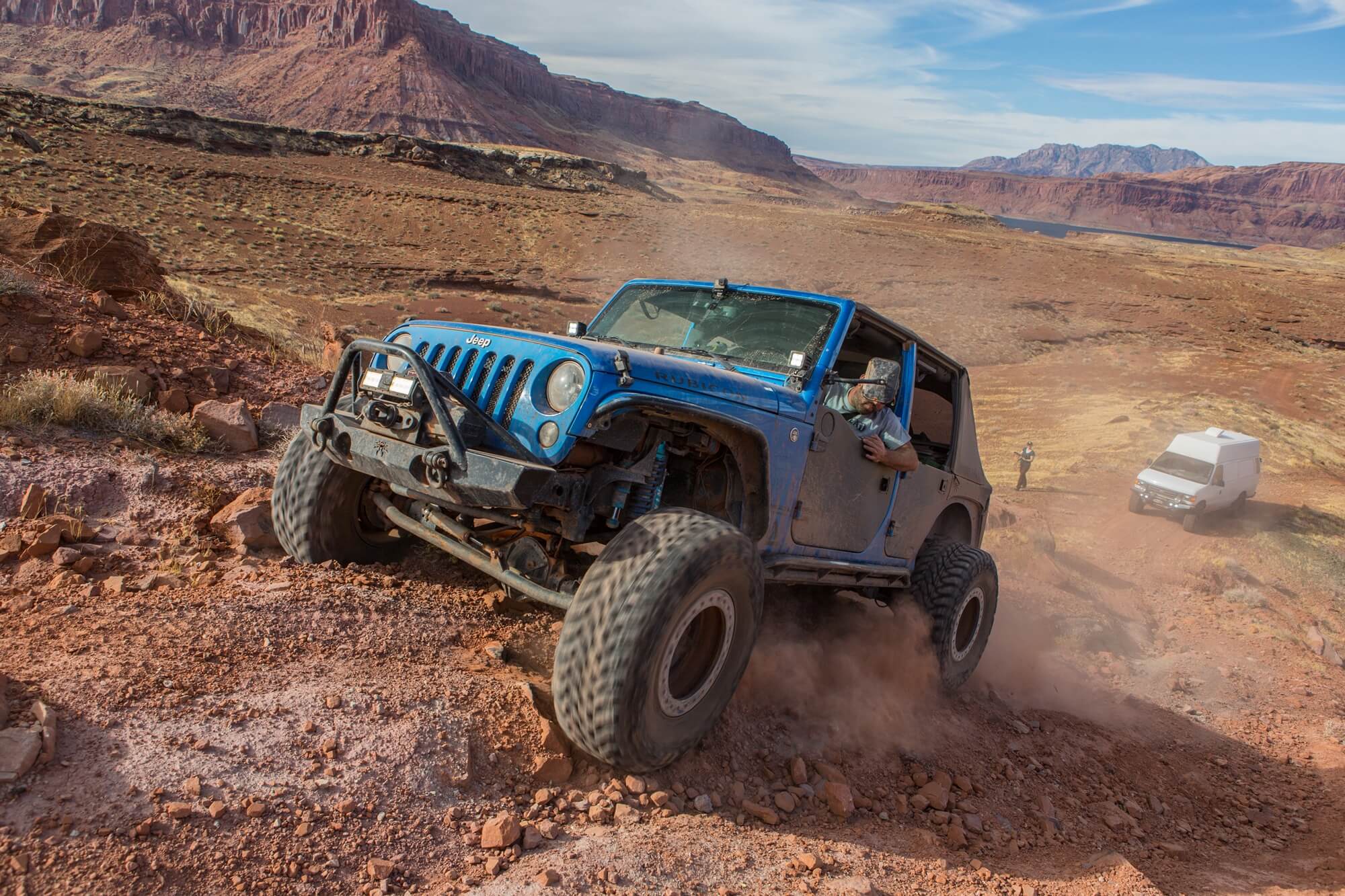
Photography by Harry Wagner
When most people think of off-roading in Utah they think of Moab, but there are literally millions of acres of public lands to explore in Utah, comprising 42% of the total land in the state. Looking to explore beyond the beaten path, we met up with backcountry trail guide Chris Ridgway to discover some of Utah’s lesser-known areas. Over the course of a week, we covered over 400 miles in the dirt, starting just west of Green River on I-70 and ending on the shores of Lake Powell. Ridgway took us though Eagle Canyon, crossing 200 feet under the interstate above. If you have ever traveled through this area and stopped at the Salt Wash Viewing Area, you have an idea of just how expansive the network of canyons are here.
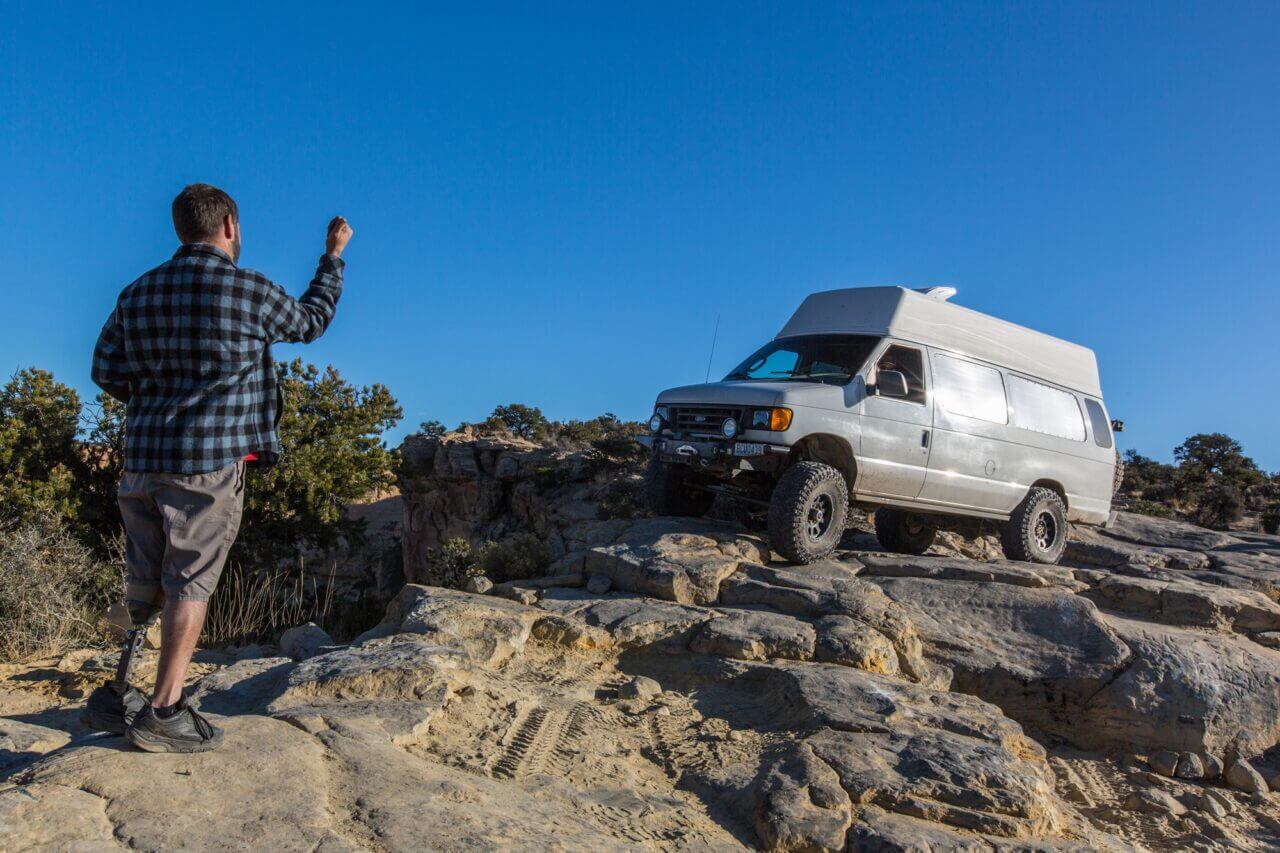
At the crux of the Devil’s Racetrack, with a narrow shelf along a sheer cliff, we encountered a local Jeep club. Our group consisted of two Ford vans, a four door Jeep Wrangler JK, and the author’s Toyota pickup. Imagine the surprise on their faces when they watched these Econoline vans traverse the same terrain that they just conquered!
We meandered through the 217,000 acres of the San Rafael Swell Recreation Area, traversing the Devil’s Racetrack Trail. Everyone was grateful to have Ridgway at the helm, as the area is crisscrossed with multiple roads. Our destination for the first night was at the bottom of the ominous Fix It Pass, in the shadow of Slipper Arch, one of the numerous natural arches in the area. Just like in Arches National Park, these features are made when snowmelt pools in fractures and other cavities, then freezes and expands, breaking off chunks of sandstone. Small recesses develop and grow bigger with each storm. Little by little, this process turns fractured rock layers into fins, and fins into arches.
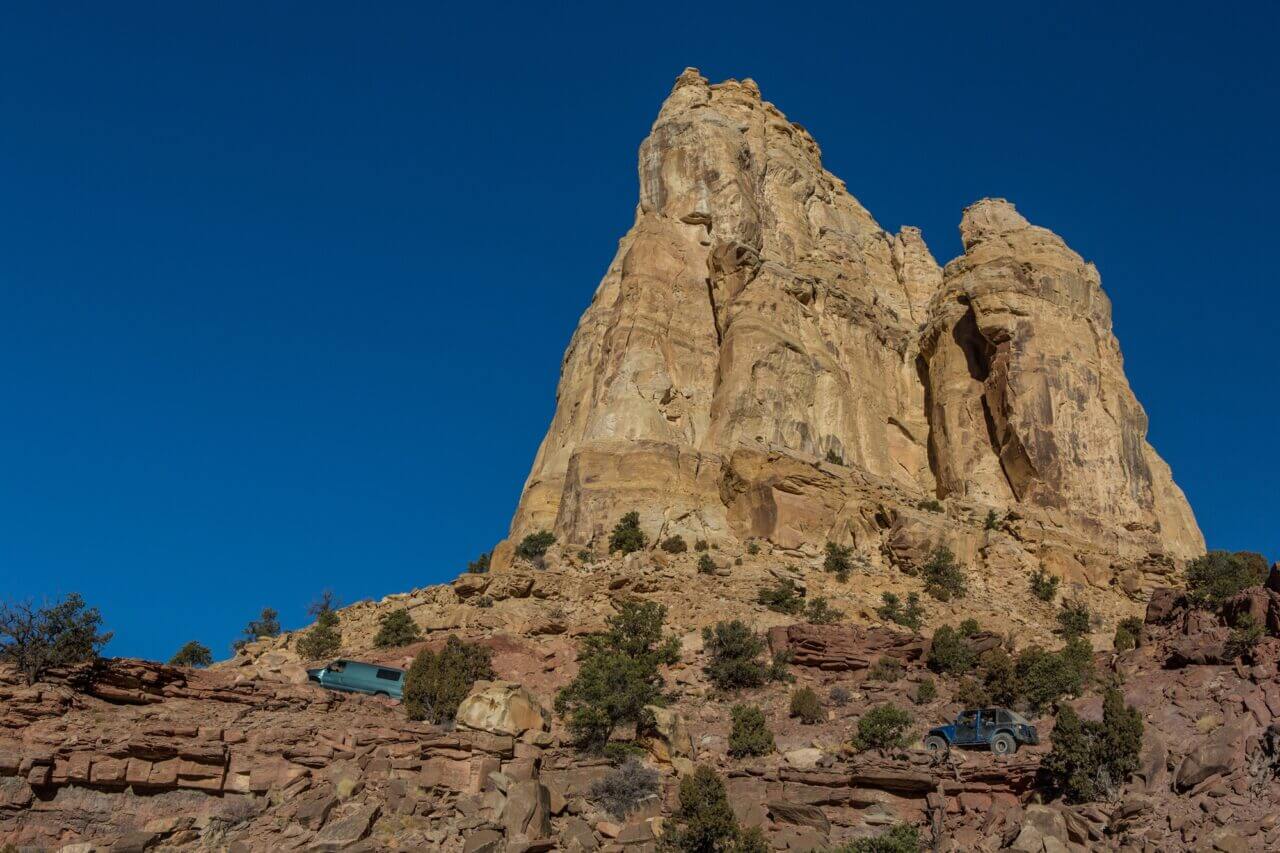
Morning of the second day took us up Fix It Pass, which fortunately did not live up to its name on this day. The climb is loose and contains numerous switchbacks, but low range and steady throttle with no tire spin allowed everyone to get through without issue. Since we were covering hundreds of miles in the dirt, everyone aired their tires down for increased traction at the beginning of the trip.
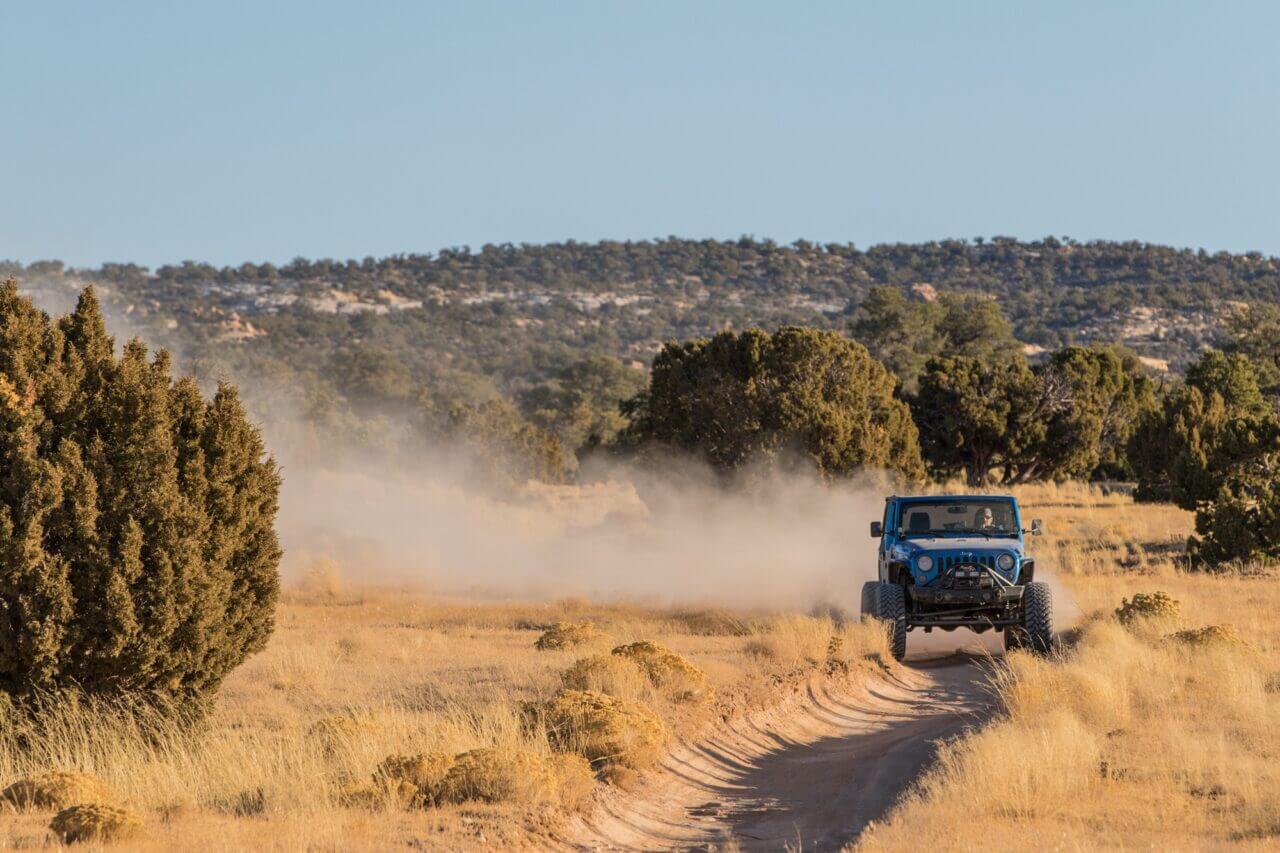
Devil’s Racetrack is a popular area for day use and overnight trips. Travel is restricted to existing roads, but the area contains enough roads that you never have to worry about finding one that leads where you want to go. On the contrary, it is difficult to figure out which road you want to be one. We recommend an atlas and/or a mapping app if you come to the area.
Day two took us back under the interstate to Goblin Valley State Park, so named because of the shapes of the hoodoos (rock formations). Cowboys searching for cattle first discovered secluded Goblin Valley. Then in the late 1920s, Arthur Chaffin, owner/operator of the Hite Ferry, explored the area while searching for a route between Green River and Caineville. The valley was acquired by the state of Utah and in 1964 was officially designated a state park. While we just passed through Goblin Valley, there are enough hikes and attractions that you could spend a week in just this park and still not see everything it has to offer.
Our only time on pavement was in Hanksville, where we refueled and restocked prior to continuing south. The town only has a population of 200 people, but it has multiple gas stations and a grocery store. Hanksville is situated just south of the confluence of the Fremont River and Muddy Creek, which together form the Dirty Devil River, which then flows southeast to the Colorado River. We continued south out of town on State Route 95 between Capitol Reef National Park and Canyonlands National Park. We peeled off the pavement and explored the canyons used by Butch Cassidy and his Wild Bunch, looking for signs of their past hideouts and lookout points when lawmen followed them into the canyonlands. Our campsite for the night was on the shores of the Dirty Devil River, fitting the outlaw theme of the region.
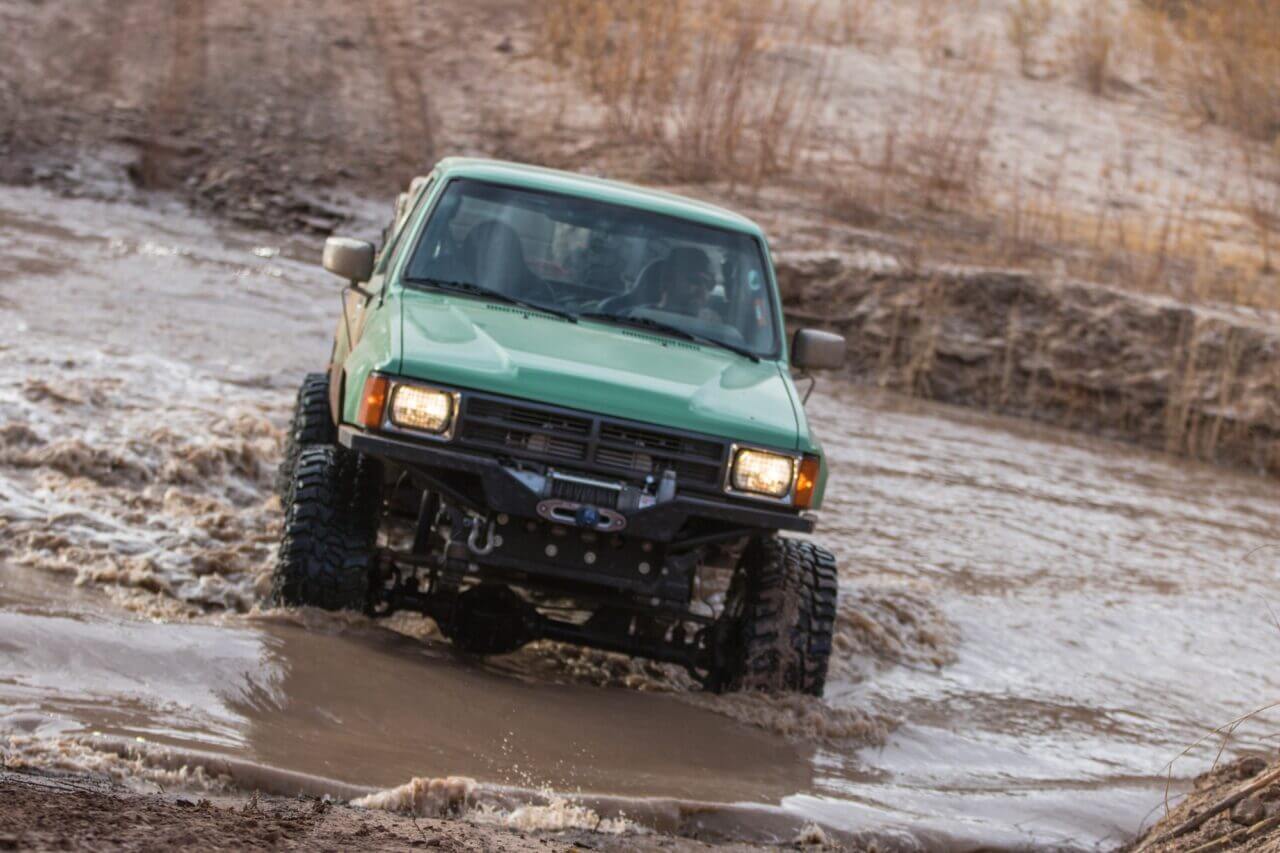
The Dirty Devil River lived up to its name, carrying lots of muddy sediment downstream. The river was relatively deep during our visit in November due to recent heavy rains. In the summer the river is barely deep enough to wet your tires when you are crossing it.
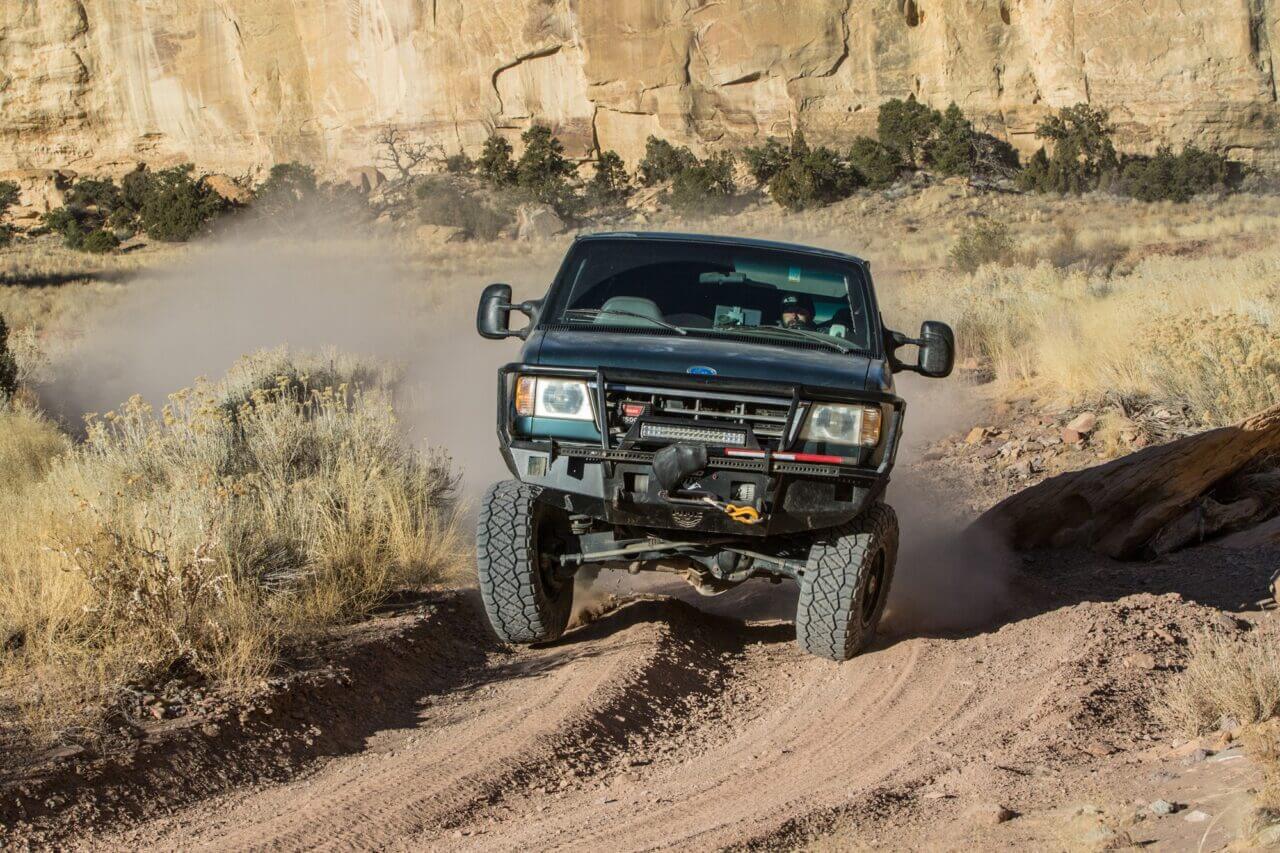
It ain’t broke! This is how twin traction beam (TTB) it supposed to work. Chris Ridgway’s van features a TTB conversion from Agile Offroad that allows it to fit 35-inch Nitto Ridge Grapplers with only a 4-inch suspension lift. This is possible since the TTB pivots around the large horseshoe crossmember under the engine that normally limits up travel on Econoline vans.
From the Dirty Devil River, Ridgway led us up and down switchbacks and plateaus past Gunsight Butte before crossing the mighty Colorado River at Hite. While the Dirty Devil is passable in a 4×4, the Colorado River definitely is not. We continued along the eastern side of the river before taking Blue Notch Road to the shores of Lake Powell. Formed from the Glen Canyon Dam across the Colorado River, Lake Powell is the second largest reservoir in the United States (behind Lake Mead). Severe drought and overallocation of water have caused the reservoir to drop to dangerously low levels, and we had to continue far past the traditional campsites along the old shore line before making it to the water’s edge for the night. Our final day on the trail was through Red Canyon. This was the most technical section of all, with narrow, off camber tracks that had all the drivers puckering. Ridgway had been this way before though and was confident the group could make it through the washed-out trail unscathed, and he was right. We fueled up at Hall’s Crossing before taking the ferry north to the town of Bullfrog and going our separate ways. On the ferry there was already talk about the next trip to Utah though, and no one mentioned Moab this time.
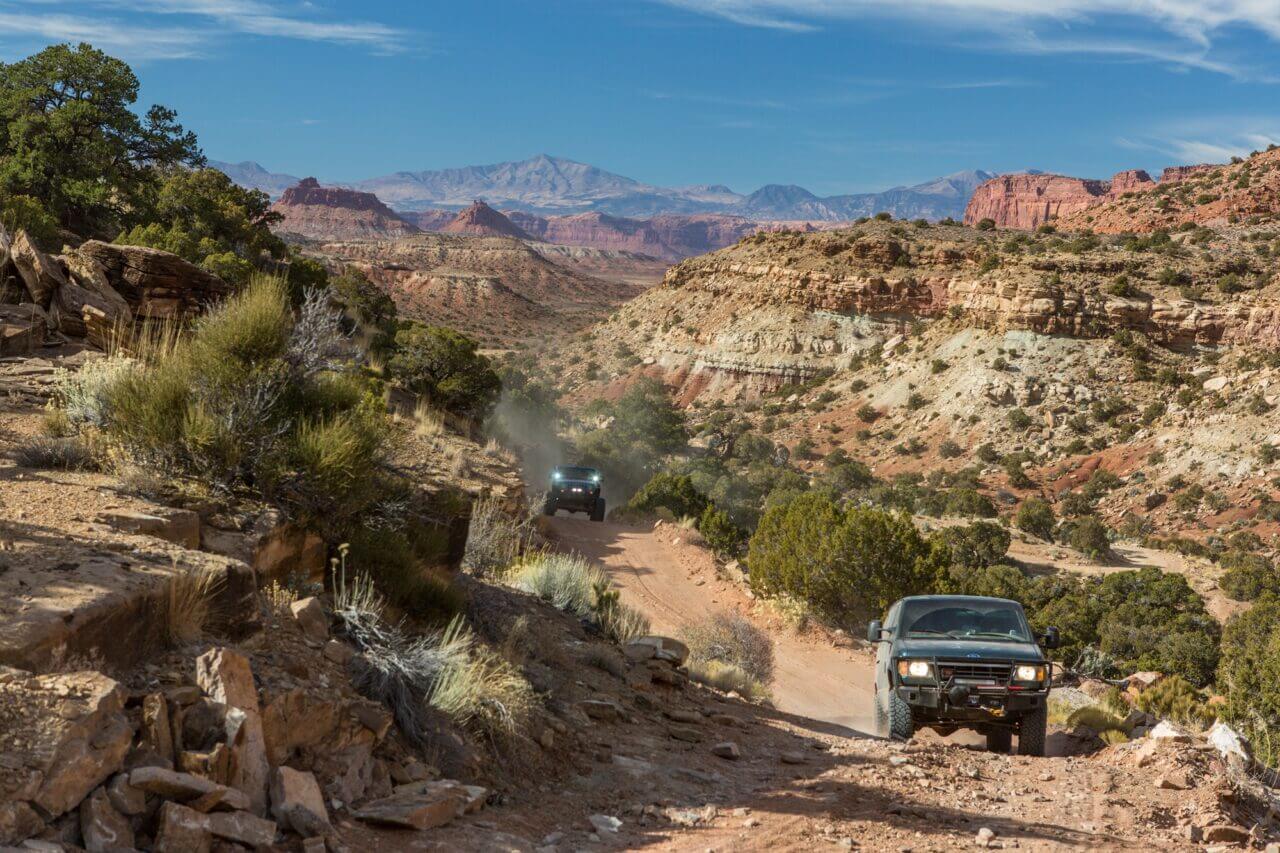
While we were able to cover around 75 miles a day on the established roads through the San Rafael Swell, it isn’t difficult to imagine the hardships that early settlers had to endure in this area. Oftentimes they would only be able to travel a mile or two per day by wagon, and both water and food sources are in short supply. Still, the rugged nature of this area is a large part of the appeal and it remains wild and relatively untouched to this day.
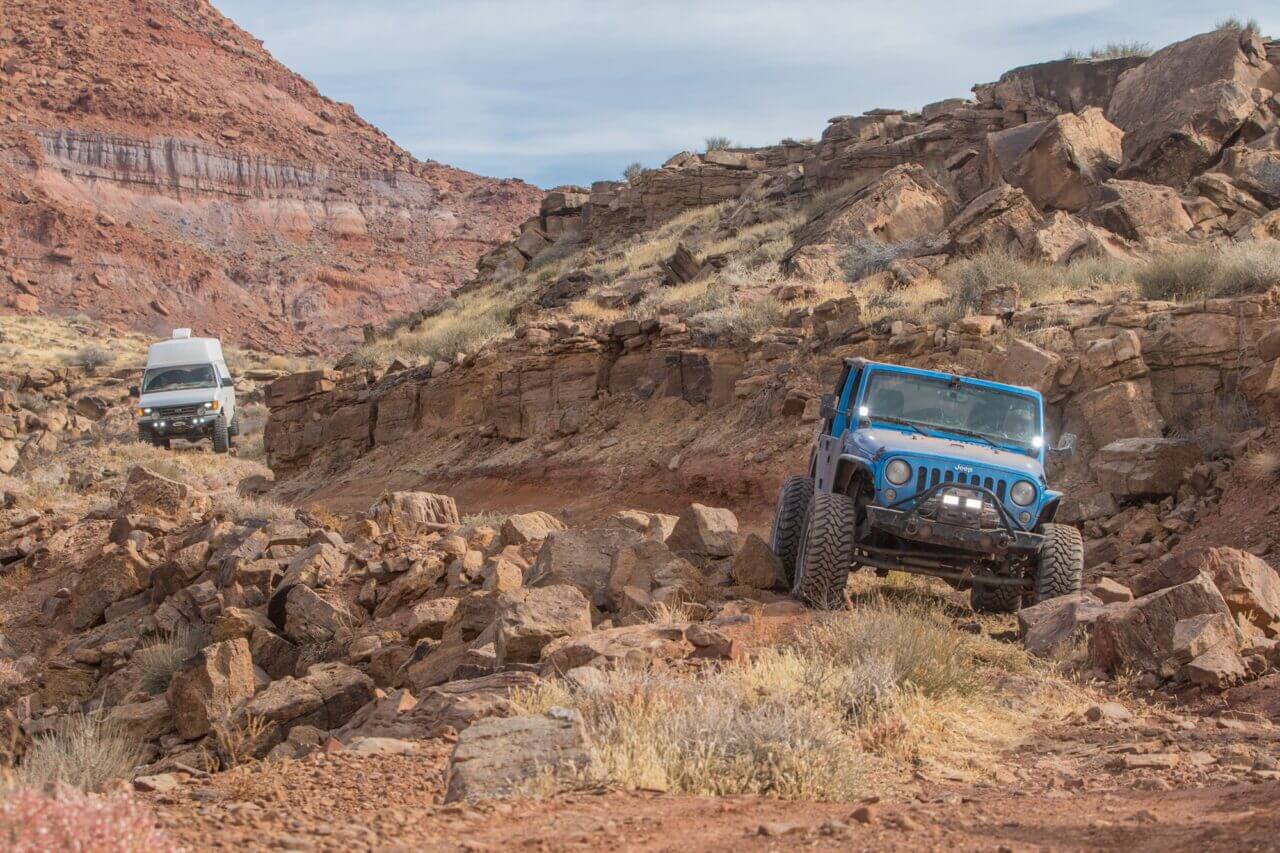
Brian Giometti had the lone Jeep on the trip, and since he left his hard top at home, he also digested the most red dust. Brian’s Jeep makes room for 37-inch Toyo Open Country M/Ts through the use of King coilovers and Poison Spyder Customs tube fenders. The front Poison Spyder Customs bumper holds a Warn winch and Rigid Industries LED lights.
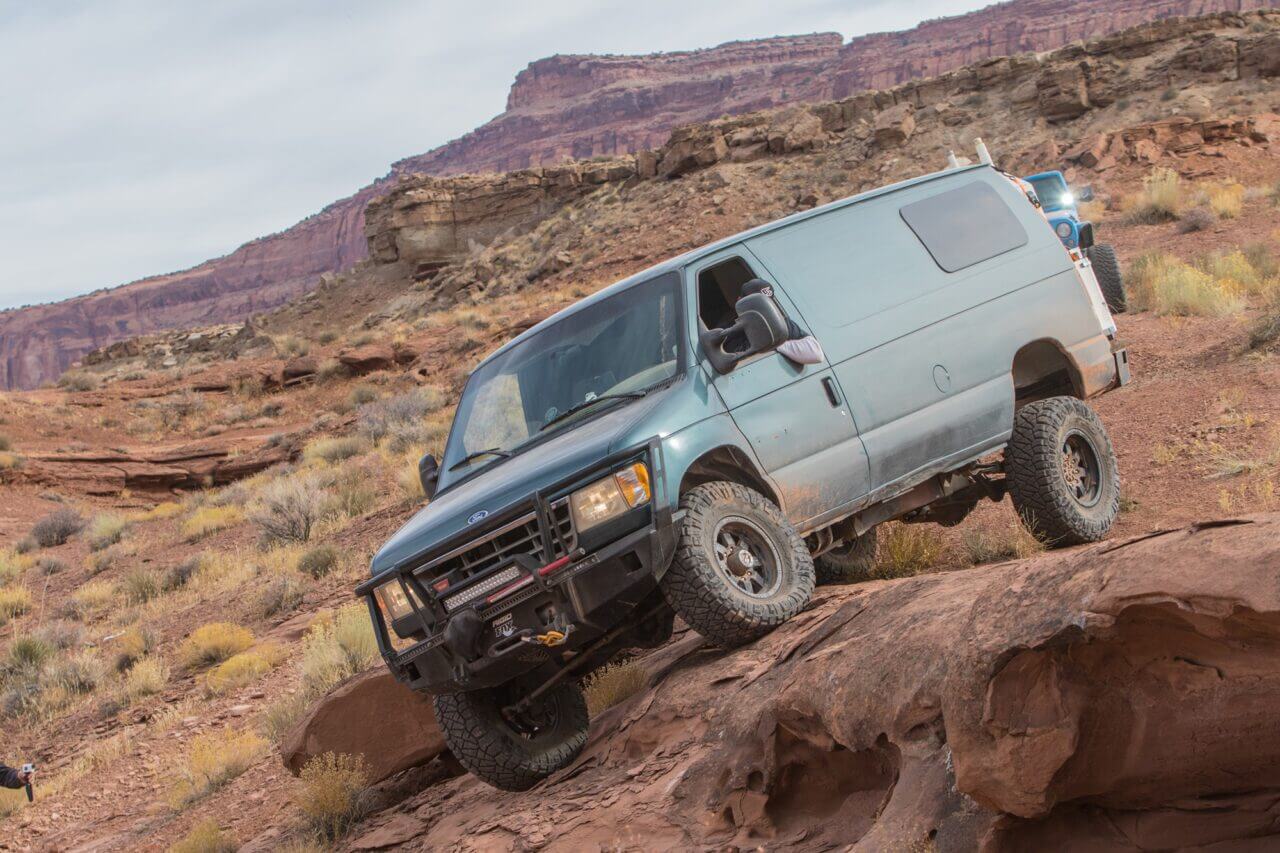
Vans have a reputation for sticking to gravel roads, but Chris Ridgway treats his Econoline like a rock crawler. In fact, when leading trips he typically has a military trailer in tow behind his van! A full floating 14 Bolt axle was swapped into the rear of the van and fitted with an ARB Air Locker for the ultimate in traction and reliability, if not ground clearance.
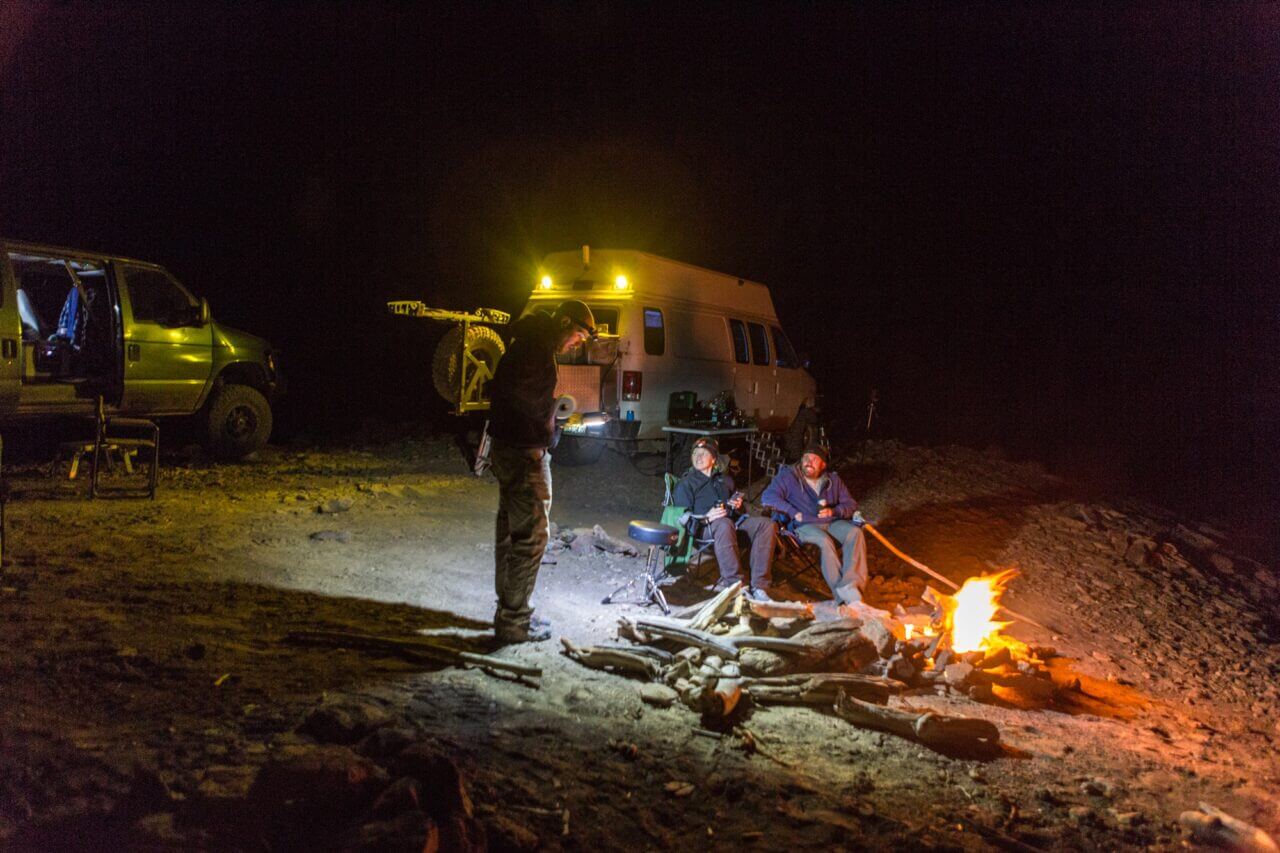
Our last night of the trip we camped on the shores of Lake Powell. The lake can be crowded with houseboats and jet skis around Page, but further up the reservoir we did not see another soul on the secluded shores. We didn’t see any firewood either, so we recommend bringing your own along.
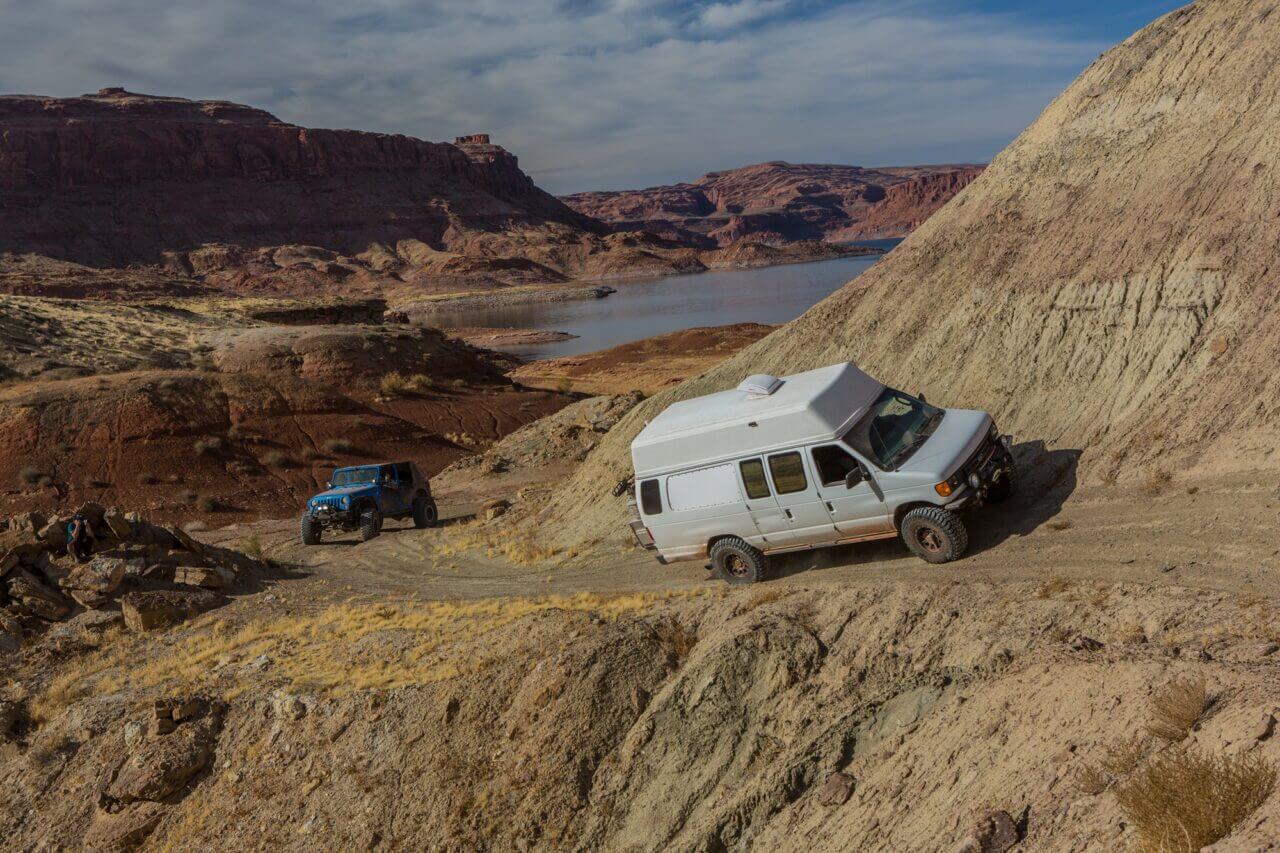
Marcus Williams brought his extended, high top Econoline to Utah from his home in Washington. It was the biggest and heaviest vehicle on the trip, but also the most comfortable inside. This van started as a shuttle at a church in Louisiana and Marcus flew all the way out to get it since it had a 7.3L engine with low miles. He then added a Dana 60 front axle, 37-inch Cooper STT Pro tires, and a host of other modifications.

The ferry runs from Halls Crossing north to Bullfrog across Lake Powell four days a week, Thursday through Sunday. The ferry departs Halls Crossing at even hours (8 AM to 4 PM) and returns from Bullfrog on odd hours (from 9 AM to 5 PM). It takes about an hour to make the crossing but saves four hours of driving.














2